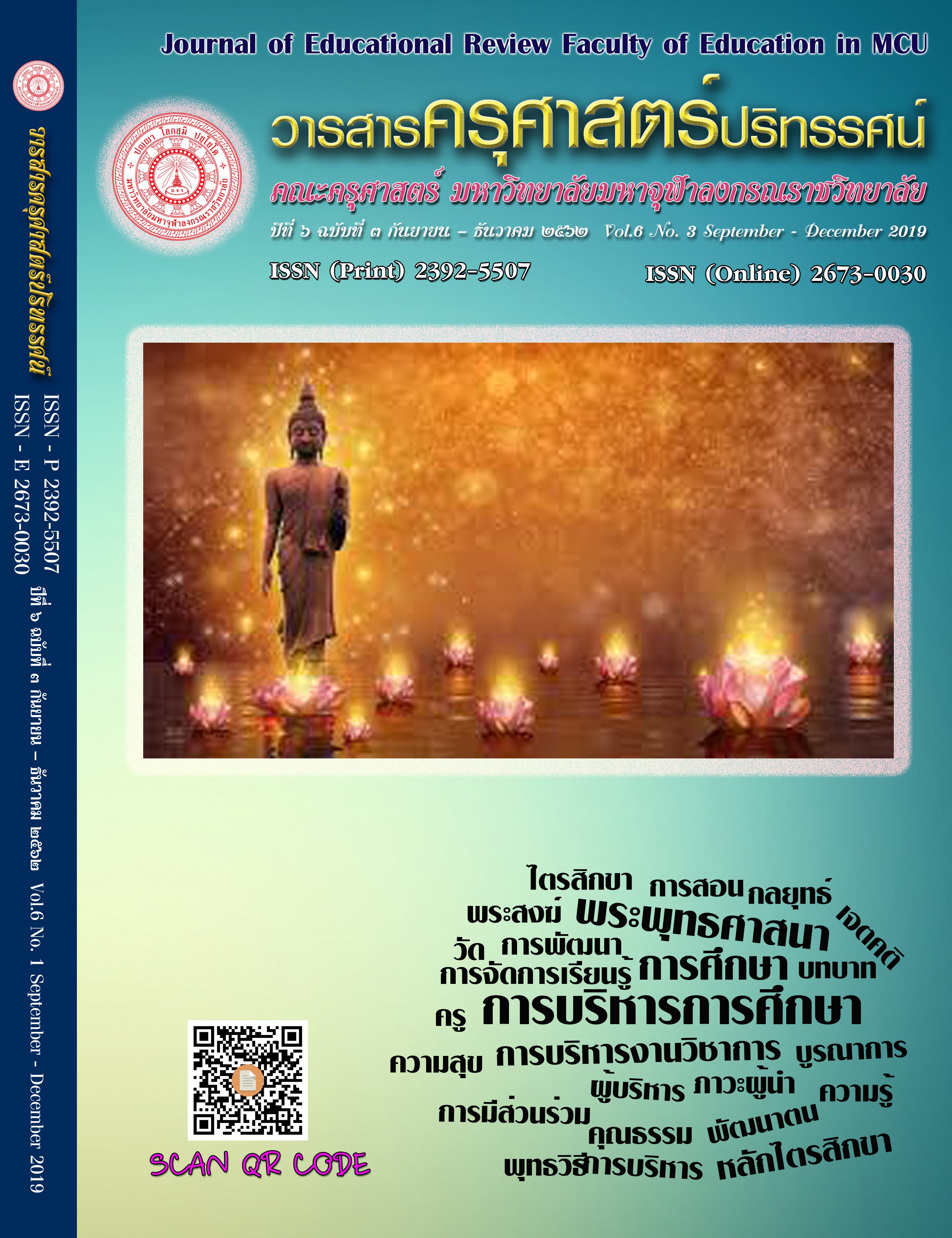A STUDY OF FACTORS AFFECTING THE TEACHER AND STAFF IN THEIMPLEMENTATION OF QUALITY ASSURANCE FOR THE SCHOOL IN THE SAKAEO PROVINCIAL ADMINISTRATION ORGANIZATION
Main Article Content
Abstract
The study aimed 1) to study the level of participation of teachers and staff the implementation of quality assurance for the School in the Sakaeo Provincial Administration Organization 2) to study the level of knowledge and understanding of the leadership attitude toward quality assurance for the School in the Sakaeo Provincial Administration Organization 3) To study personal factors affecting the participation of teachers and staff in the implementation of quality assurance for the Sakaeo Provincial Administration Organization, and และ 4) to analyze relationships of knowledge, understanding and leadership attitudes of quality assurance and participation of teacher and staff in the implementation of quality assurance for the School in the Sakaeo Provincial Administration Organization.
The research methodology was a quantitative research that uses survey methodology by collecting the data from the questionnaire. The sample consisted of 274 of teachers and staffs for the School in the Sakaeo Provincial Administration Organization. The validity and reliability of assessment tools was conducted based on 30 Cronbach’s Alpha Formula. The result of reliability of assessment tools was 0.923 and index of item – objective congruence was 0.89. Descriptive data analysis included frequency, percentage, average, standard deviation, and quantitative data analysis was made with T-test statistics, F-test, Least Significant Difference (LSD), and correlation test was made with Pearson's Correlation Coefficient test at .05 significant levels. SPSS software was used for analyzing data and running statistical tests. Results In term of personal factors, it is found that most of respondents are female rather than male, aged 36-40 years , master degree, and followed by under graduate degree. They have more than 20 years of work experience, school responsibility were teacher, followed by head of a department, deputy director and small number of academic affairs department , the director and the least was head of quality assurance. The Teacher and the staff have the highest level of knowledge and understanding of quality assurance. by setting the indicators and criteria for quality assurance, at the highest level. Each school can be further specified indicators and criteria to the Office for National Education Standards and Quality Assessment (ONESQA,), by indicated the attitudes towards quality assurance in education, education creates of knowledge, skills and confidence for the teachers and the staff at the highest level, and the teacher and the staff have leadership in quality assurance in education at the highest level. The area should have agricultural products with the same standardize prices was at the highest level, and implementation of quality assurance for the School in the Sakaeo Provincial Administration Organization was the highest level. Development and improvement of quality assurance in school, evaluation, assessment and quality assurance of education, quality assurance of education planning, and implementation of quality assurance activities, were at the highest level, respectively.
The results or hypothesis testing on personality factors indicated that sex, age, education level, work experience and position affect implementation of quality assurance for the school in the Sakaeo Provincial Administration Organization, differently The report of a correlation revealed that knowledge, understanding, attitudes and leadership toward quality assurance in school correlated with implementation of quality assurance for the school in the Sakaeo Provincial Administration Organization. It was found that the knowledge, understanding and attitudes towards quality assurance in school had a positive correlation with implementation of quality assurance, quality assurance of education planning at the highest level, and leadership on quality assurance in education was positively correlated with implementation of quality assurance in school, by indicating that development and improvement of quality assurance had highest correlation.
Article Details
ทัศนะและความคิดเห็นที่ปรากฏในบทความในวารสารฉบับนี้ถือเป็นความรับผิดชอบของผู้เขียนบทความนั้นเพียงผู้เดียว และไม่ถือเป็นทัศนะและความรับผิดชอบของกองบรรณาธิการ
กองบรรณาธิการขอสงวนสิทธิ์ในการคัดเลือกบทความลงตีพิมพ์และจะแจ้งให้เจ้าของบทความทราบหลังจากผู้ประเมินบทความตรวจอ่านบทความแล้ว
ต้นฉบับที่ได้รับการตีพิมพ์ในวารสารครุศาสตร์ปริทรรศน์ คณะครุศาสตร์ มหาวิทยาลัยมหาจุฬาลงกรณราชวิทยาลัย ถือเป็นกรรมสิทธิ์ของคณะครุศาสตร์ มหาวิทยาลัยมหาจุฬาลงกรณราชวิทยาลัย ห้ามนำข้อความทั้งหมดหรือบางส่วนไปพิมพ์ซ้ำ เว้นเสียแต่ว่าจะได้รับอนุญาตจากมหาวิทยาลัยฯ เป็นลายลักษณ์อักษร
References
ประศาสน์ สองแคว .(2549). การพัฒนาระบบงานประกันคุณภาพการศึกษาที่เอื้อต่อการปฏิรูปการเรียนรู้โดยความร่วมมือระหว่างโรงเรียนกับชุมชนในเขตพื้นที่บริการของโรงเรียนบ้านแต (กวีรัตน์ราษฎร์บำรุง) อำเภอแพร่ จังหวัดแพร่. วิทยานิพนธ์รัฐศาสนศาสตรมหาบัณฑิต. บัณฑิตวิทยาลัย : มหาวิทยาลัยบูรพา.
ประสาน แบงเพชร. (2548). การมีส่วนร่วมของครูในการดำเนินการ ประกันคุณภาพภายในสถานศึกษาขั้นพื้นฐาน สังกัดสำนักงานเขตพื้นที่การศึกษาสุพรรณบุรี. วิทยานิพนธ์ครุศาสตรมหาบัณฑิต สาขาวิชาการบริหารการศึกษา. บัณฑิตวิทยาลัย : มหาวิทยาลัยราชภัฏกาญจนบุรี.
วารินทร์ สินสูงสุด. (๒๕๔๓). การประกันคุณการศึกษา. กรุงเทพมหานคร: สยามมิตรการพิมพ์.
สำนักงานคณะกรรมการการศึกษาแห่งชาติ. (2545). พระราชบัญญัติการศึกษาแห่งชาติ พ.ศ. ๒๕๔๒ และแก้ไขเพิ่มเติม ฉบับที่ ๒ พ.ศ. ๒๕๔๕. กรุงเทพมหานคร : พริกหวานกราฟฟิก.
สำนักทดสอบทางการศึกษา. (2553). แนวทางการพัฒนาระบบการประกันคุณภาพภายในของสถานศึกษาตามกฎกระทรวงว่าด้วยระบบหลักเกณฑ์และวิธีการประกันคุณภาพการศึกษา พ.ศ. 2553. กรุงเทพมหานคร : สำนักงาคณะกรรมการการศึกษาขั้นพื้นฐาน.


